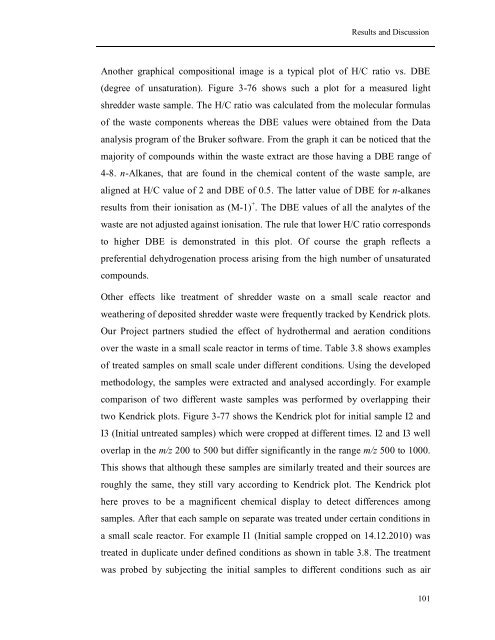Development of a Novel Mass Spectrometric ... - Jacobs University
Development of a Novel Mass Spectrometric ... - Jacobs University
Development of a Novel Mass Spectrometric ... - Jacobs University
You also want an ePaper? Increase the reach of your titles
YUMPU automatically turns print PDFs into web optimized ePapers that Google loves.
Results and Discussion<br />
Another graphical compositional image is a typical plot <strong>of</strong> H/C ratio vs. DBE<br />
(degree <strong>of</strong> unsaturation). Figure 3-76 shows such a plot for a measured light<br />
shredder waste sample. The H/C ratio was calculated from the molecular formulas<br />
<strong>of</strong> the waste components whereas the DBE values were obtained from the Data<br />
analysis program <strong>of</strong> the Bruker s<strong>of</strong>tware. From the graph it can be noticed that the<br />
majority <strong>of</strong> compounds within the waste extract are those having a DBE range <strong>of</strong><br />
4-8. n-Alkanes, that are found in the chemical content <strong>of</strong> the waste sample, are<br />
aligned at H/C value <strong>of</strong> 2 and DBE <strong>of</strong> 0.5. The latter value <strong>of</strong> DBE for n-alkanes<br />
results from their ionisation as (M-1) + . The DBE values <strong>of</strong> all the analytes <strong>of</strong> the<br />
waste are not adjusted against ionisation. The rule that lower H/C ratio corresponds<br />
to higher DBE is demonstrated in this plot. Of course the graph reflects a<br />
preferential dehydrogenation process arising from the high number <strong>of</strong> unsaturated<br />
compounds.<br />
Other effects like treatment <strong>of</strong> shredder waste on a small scale reactor and<br />
weathering <strong>of</strong> deposited shredder waste were frequently tracked by Kendrick plots.<br />
Our Project partners studied the effect <strong>of</strong> hydrothermal and aeration conditions<br />
over the waste in a small scale reactor in terms <strong>of</strong> time. Table 3.8 shows examples<br />
<strong>of</strong> treated samples on small scale under different conditions. Using the developed<br />
methodology, the samples were extracted and analysed accordingly. For example<br />
comparison <strong>of</strong> two different waste samples was performed by overlapping their<br />
two Kendrick plots. Figure 3-77 shows the Kendrick plot for initial sample I2 and<br />
I3 (Initial untreated samples) which were cropped at different times. I2 and I3 well<br />
overlap in the m/z 200 to 500 but differ significantly in the range m/z 500 to 1000.<br />
This shows that although these samples are similarly treated and their sources are<br />
roughly the same, they still vary according to Kendrick plot. The Kendrick plot<br />
here proves to be a magnificent chemical display to detect differences among<br />
samples. After that each sample on separate was treated under certain conditions in<br />
a small scale reactor. For example I1 (Initial sample cropped on 14.12.2010) was<br />
treated in duplicate under defined conditions as shown in table 3.8. The treatment<br />
was probed by subjecting the initial samples to different conditions such as air<br />
101
















